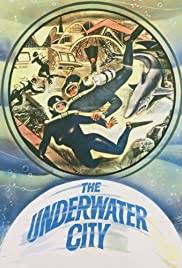
Tim Graham (Roy Roberts) owns the Graham and Co. Engineering and Construction Company. They have been bidding for a contract to make a space station. His best engineer Bob Gage (William Lundigan) has been planning it. Graham calls him into the office to tell him they didn’t get the contract for the space station but they did get a contract. The company will instead be building an undersea city called Amphibia City. Gage’s experience in underwater demolition is one of the reasons Graham and Co. got the contract. Gage is not happy about the change in projects.
Oceanographer Dr. Junius Halstead (Carl Benton Reid), the head of the Halstead Institute of Oceanography is responsible for hiring the engineering company to build the city. After meeting Gage he is beginning to have second thoughts about his choice. Graham assures him that even though Gage is not thrilled with the project he is still the best man for the job.
When Gage meets the project’s psychologist, and Halstead’s niece, Dr. Monica Powers (Julie Adams) he is a little more enthusiastic but his enthusiasm is more for the doctor and not the underwater city. Also enlisted for the project are newlyweds Lt. Wally Steele (Edward Mallory) and Dotty Steele (Kathie Browne). Wally is a Navy man and the adventure underwater at the facility is part of their honeymoon. Dietician Phyllis Gatewood (Karen Norris) is recruited to do experiments in underwater farming and creating dishes that use what they grow to create tasty and nutritious meals to prove that underwater farming is the future in terms of ensuring enough food to feed the world.
Gage explains to the crew and Dr. Halstead how the city will be built. The buildings will be a series of watertight modules. The modules will be made on land and then anchored to the bottom of the ocean. The design is a series of underwater living units that will be connected by corridors. They are built and placed underwater. The team move in and begin their underwater experiments. Everything is going well until the new geophysical engineer, George Burnett (Paul Dubov), discovers that the structure was built on a fault that is quickly disintegrating.
“The Underwater City” was released in 1962 and was directed by Frank McDonald. The Columbia Pictures film was done in color; however, the film that was sent to theaters was black and white. The version released to television was in color. Why? Nobody knows for sure.
The filming of the picture was fraught with problems. One of the major ones was star Lundigan’s alcoholism. Another issue was the fact that on the ocean floor set the actor’s breathing equipment made helium filled bubbles. Normally a nice effect, however, after they went up, they came back down. To solve the problem stage hands had to use fans to blow the bubbles away before they could come back down again. The film was plagued with other problems and the final straw was when the film was released in theaters in black and white. At that point Neptune Productions sued Columbia Pictures. It dragged on for about five years before the suit ended up just fizzling out.
Pretty much all of the movie was filmed indoors on sound stages. The underwater scenes were created either by “dry for wet” filming or through a double-paned glass water-filled aquarium. Special effects were done by Howard Lydecker. The use of miniatures made the octopus and eel look like giants. There size was impressive, unfortunately they didn’t do much.
The commentary drones on. Most of the acting is fine. Julie Adams as Monica is sweet but Karen Norris as Phyllis is delightful and easily steals whatever scene she’s in. Lundigan as Bob Gage is mildly annoying and appears to be sober. The film is very Disney-esque and Irwin Allen-esque, similar to “20,000 Leagues Under the Sea” 1954, “Voyage to the bottom of the Sea” 1964 or “Around the World Under the Sea” 1966. It’s light family entertainment. “Aquaman” 2018 it is not.

